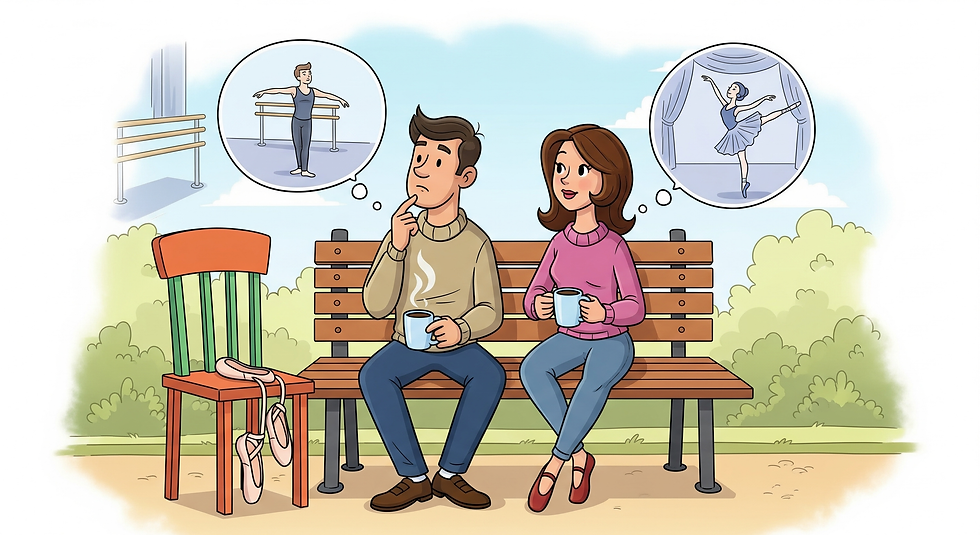How to remember ballet class as an adult
- Sophie Fletcher
- Jul 25
- 4 min read
What you'll learn in this article:
Memory for choreography is harder for adults due to natural changes in neuroplasticity and working memory.
Dance is proven to enhance neuroplasticity, memory, and attention - even later in life.
Practical memory strategies can make learning easier and more enjoyable.
Adult ballet classes can be deeply rewarding, but many dancers find remembering new steps and choreography surprisingly challenging. Scientific research reveals that this isn’t just a personal struggle - there are clear biological and psychological reasons why adults may find memory for dance harder than children or lifelong dancers.
The good news? The same principles that make memorising movement difficult can also be harnessed to improve memory and brain health. So here is why it happens, and what you can do about it.

Why is it difficult to remember ballet combinations as an adult?
Neuroplasticity: The brain’s adaptability
Neuroplasticity refers to your brain’s ability to form new connections and adapt. While the brain is highly plastic in childhood, allowing young people to learn new skills quickly, this ability gradually decreases with age. This shift makes acquiring complex motor skills - like ballet combinations - more effortful for adults. However, repeated challenging activities, such as dance, can enhance neuroplasticity even later in life.
Working memory and attention
Memorising new choreography heavily relies on working memory, the mental space where you temporarily store and process new information. Working memory tends to peak in young adulthood and decline modestly as we age, making it harder to hold several new steps in your mind at once. Dance learning also demands multitasking: listening to instructions, processing technique corrections, and physically moving in time. This adds further cognitive load.
Motor memory and movement patterns
Adults who started ballet later in life lack the deep, hard-wired movement patterns developed by those who began as children. Building these neural movement maps from scratch takes repetition and time. Practice solidifies these patterns into motor memory, eventually making sequences feel more automatic.
Psychological factors
Adults often bring critical thinking and self-monitoring to class, which can be both helpful and hindering. Attentional demands, anxiety about performance, and concerns over mistakes can sap mental resources away from memory and movement.
The good news: Your brain can change!
Despite these hurdles, science shows that adult brains remain capable of significant growth:
Dance boosts brain health
Regular dance training increases brain volume and connectivity in regions linked to memory, motor control, and spatial reasoning. Even among older adults.
Improvement with practice
Older adults can learn and consolidate new motor skills with consistent, focused practice. Unlike simple exercise, dance - especially when continually requiring new learning - induces more pronounced improvements in brain structure and memory than repetitive fitness routines.
Lasting change
Dance interventions have been shown to improve cognitive function, attention, and memory in older populations, with benefits persisting for months after training.
Practical strategies to remember choreography
Embrace repetition
Frequent practice helps reinforce motor pathways. Repeating combinations inside and outside of class (even mentally) aids memory consolidation.
Chunk Information
Break down combinations into sections or “chunks.” This working memory strategy makes longer sequences easier to manage and recall.
Use multiple senses
Observe, listen to music cues, quietly count out loud, and physically mark steps. Multisensory engagement supports stronger neural connections.
Be patient with yourself
Progress may seem slow, but each class helps retrain your brain for better memory and learning. Celebrate small wins.
Prioritise sleep and rest
This one is probably the least surprising. Memory encoding and consolidation happen during rest and sleep. Prioritizing good sleep can help you retain what you learn.
So don't despair! Remembering ballet steps and routines can be challenging but it's natural, shared among all adult ballet learners and can be overcome by regular practice which in turn builds up your brain health and confidence.
Speaking of regular practice, there is never a better time to start then today.
Additional resources
If you'd like to learn more, you can explore some of the articles below:
A full thesis looking at the behavioral working memory differences between dancers and non-dancers.
This review summarizes evidence that dance programs can induce expressive brain plasticity at both structural and functional levels.
Examines the effectiveness of dance interventions for cognitive function, memory, and brain health in older adults.
Reviews how dance can induce neuroplastic changes improving both motor and cognitive functions in adults.
Synthesises neuroimaging evidence for neuroplasticity after music and dance-based interventions in clinical and aging populations.



Comments